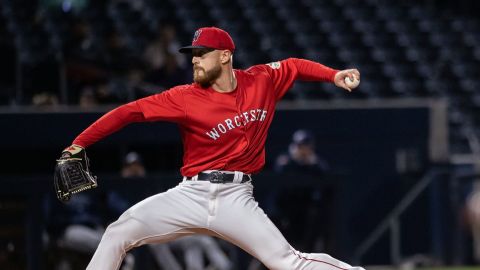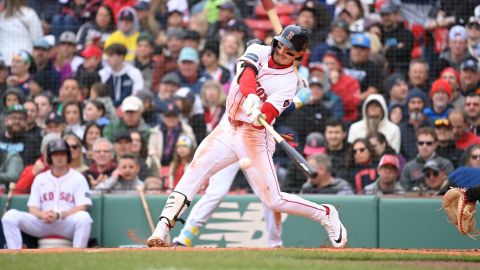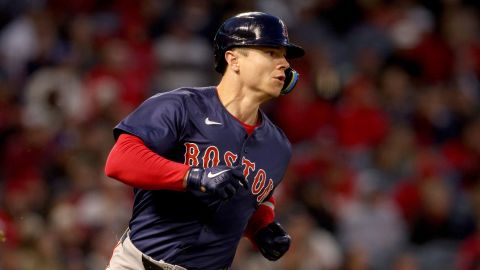 Before even beginning this investigation, I must begin with a disclaimer: Of course the Red Sox’ eight-year, $110 million extension with Dustin Pedroia is not all about dollars and cents. As if it needs to be said by yet another media pundit, Pedroia is (arguably) the face of the Red Sox franchise, the heart and soul of the team, and his importance to Boston goes beyond what can be quantified.
Before even beginning this investigation, I must begin with a disclaimer: Of course the Red Sox’ eight-year, $110 million extension with Dustin Pedroia is not all about dollars and cents. As if it needs to be said by yet another media pundit, Pedroia is (arguably) the face of the Red Sox franchise, the heart and soul of the team, and his importance to Boston goes beyond what can be quantified.
But that being said, it would be insanely naive to say that, conversely, Pedroia’s extension is not at all based on his on-field performance, or that Red Sox general manager Ben Cherington and his staff haven’t crunched the numbers to determine Pedroia’s actual dollar value in terms of what can be measured. In this day and age, we’ve seen time and time again that many teams simply don’t think it’s worth it to overpay for a franchise icon with declining performance (think Albert Pujols or the Yankees playing harball with Derek Jeter‘s extension).
So, regardless of Pedroia’s intangible value to the Red Sox, it’s still absolutely worth it to investigate the likelihood that the second baseman will live up to the dollar value of his deal. After all, many of the long-term contracts we’ve seen in recent years flatly haven’t worked out for the team. While Pedroia’s contract may not be a total albatross akin to Alex Rodriguez‘s deal with New York, remember that, after the 2007 postseason, it basically would have been heresy to suggest that Josh Beckett‘s 2010 extension might have been ill-advised.
Players get older, and as their performance declines so does their value, and it will happen to Pedroia, too, eventually.
The first thing that needs to be established is the value of a win in relation to the Sabermetric-favorite stat WAR. In short, there is not an easy, linear way to translate a WAR of 1 into a dollar value. The problem is that there seems to be a baseline where players who are worth 1 WAR earn about $5 million (which is surprisingly consistent), with each additional win seeing diminishing returns.
The other problem is that as more teams have taken on a Sabermetric model in the front office, the value of a win has, unsurprisingly, risen. While the value of a win was about $4.3 million in 2008, it was about $5 million in 2012 and is expected to be above $6 million in 2017 — four years before Pedroia’s contract ends.
So, for the sake of simplicity, we’ll estimate the value of a win at $6 million over the course of Pedroia’s contract, since we can assume that the rate of win-value inflation will decline as MLB teams have caught on — at some level — to Sabermetrics. (Again, this figure won’t be exactly accurate, but it’s close enough for estimates that reach eight years into the future.)
So, let’s first look at Pedroia’s performance without accounting for a future decline. Beginning in 2006 and continuing through Tuesday (we’re discounting Pedroia’s first season) Pedroia has played in 926 games for the Red Sox, and earned a WAR of 33.2 (according to Fangraphs’ formula). For the sake of fun, I’ll point out that Pedroia has earned just more than $30 million over that time (according to Baseball Reference), meaning the Red Sox have only payed $1 million per win on Pedroia thus far in his career — an incredible value.
In any case, Pedroia has averaged 5.6 WAR for every 155 games played (we’ll estimate that as a full season), meaning that if he were to continue playing at the same level, he’d be worth approximately $33.6 million a season, more than twice as much as the annual $14.3 million value of his extension.
However, as I’ve already stated, players get older and their performance declines, and thus, it’s not reasonable to expect Pedroia to be the same player at age 37 as he is at age 29. But what sort of decline is reasonable to expect from Pedroia as he enters the latter part of his contract?
The best thing that can be said in Pedroia’s favor is that there’s nothing in his metrics to suggest an imminent decline. His TAv (true average, a Sabermetric stat that measure’s a player’s total offensive value scaled to batting average) has basically remained consistent throughout the course of his career. Pedroia’s BABIP has been on the high side, but it’s not egregious and since he’s been repeating it for his entire career it’s fair to consider it an inherent skill, not random variance.
Then again, Hall of Fame-type players don’t peak, they plateau — as did Pedroia — and all players tend to enter their decline phase after their age 30 season — Pedroia is 29. Basically, most players begin their decline by age 31, and basically all do by age 33.
Unfortunately, there’s no easy way to gauge how we think Pedroia will decline, or at what rate — the only thing we can be sure about is that he will decline, almost certainly by age 33. However, the closest analog we can look at is the average decline in WAR as players age, and the plain fact is that there aren’t many players who make much of an impact at age 37.
Jeremy Greenhouse of BaseballAnalysts.com did some statistical heavy lifting on this front:

Photo via BaseballAnalysts.com
As you can see, an average of all baseball players (this graph was created in 2010) shows that players lose about two wins from their peak seasons to their late 30s. Though it’s unlikely that Pedroia will still be a three-win player in 2021, the fact that Pedroia performs at such a high level also means that he can fall more and still retain value.
Morover, the fact that Pedroia plays second base helps him retain a lot of his value. As he ages, Pedroia will undoubtedly lose a step or two, but he’s still likely to remain a plus defender. Sabermetrics has traditionally had trouble accounting for defense, but the defense is a huge part of any middle infielder’s value, whether or not it can be properly quantified.
In short, Pedroia probably only has to average about 2.5 WAR per season through the course of his contract to return equal value to the Red Sox — at least mathematically. While he almost certainly won’t be that good by the latter part of the deal, he may well perform well enough during the first half of the contract to make it a worthy investment for the Red Sox.
In Pedroia’s news conference, Cherington specifically mentioned that Pedroia is just the kind of player you bet on to continue to be good as he gets older. Given the second baseman’s history of injury and diminutive size, that may or may not be a wise guess. But, again, it just underscores the fact that this extension was not about dollars and cents; it was about what Pedroia means to the organization, just to borrow a cliche.
However, it should also please Red Sox fans that, even as Pedroia enters his decline phase, he has a pretty good chance to actually live up to his lengthy, expensive contract.



